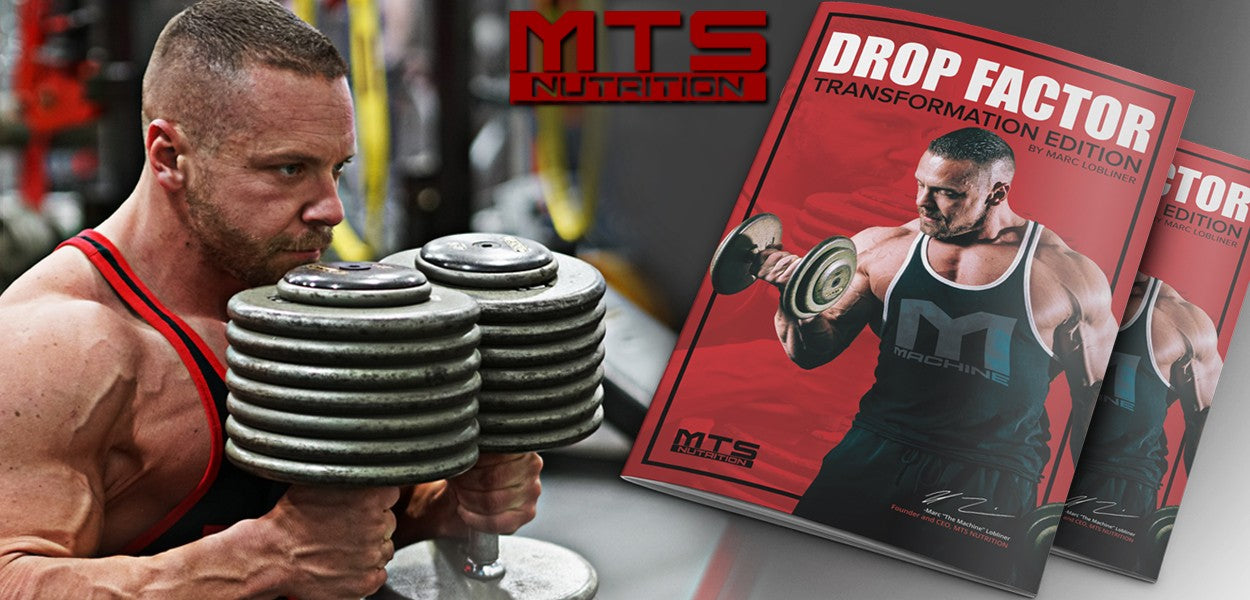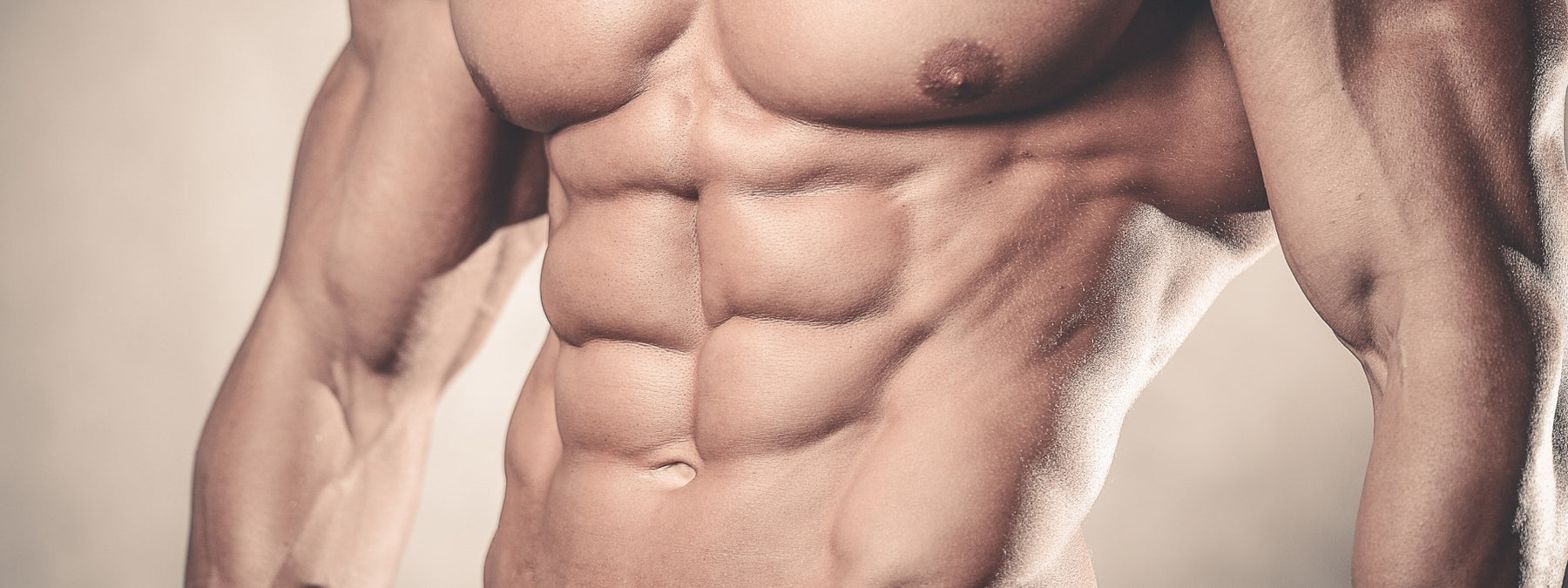Admit it. You've wondered, "How do those physique athletes and fitness models transform their bodies and make themselves look like Greek gods?" It's not Photoshop or make-up. You can't fake a ripped physique.
Even though you may not want to step on stage or grave the cover of a magazine, you still want to get shredded.
It's a combination of hard work, consistency, dietary strategy and sound supplementation. By following these tips, you'll get that dry, peeled and rock hard appearance that turns heads and not stomachs.
You've tried this before. It felt like you were giving 110% in your training and diet, but you were still a little soft around the middle. The lower back fat was still lingering. You had a glimpse of a 2-pack with perfect lighting, but it wasn't anything to celebrate over. Striations in your shoulders were nowhere to be found.
Related: The Fat Loss Factor Book by Marc LoblinerNow imagine if you had the road-map to get shredded and all the guesswork was eliminated. Wouldn't this save you tons of frustration?
If you answered yes, then you've come to the right place.
Instead of discounting the fact that you have the motivation and desire to do the work required to get shredded, this post is intended to augment your efforts in the gym and kitchen. I want to take your enthusiasm and turn it into results instead of frustration.
With these 10 tips, we're going to fine tune your approach and provide you with the guide to not only get shredded for a season, but to maintain a physique that you're proud of all year long.
Back up your cutting diet with the fat blasting Drop 6 stack which includes: MTS Drop Factor, Yohimbine HCL and HPN M(6). Order now.
10 Tips to Help You Stay Shredded
Tip #1. Add sprints
Who would you rather look like: A marathoner or a sprinter?
I have nothing against endurance athletes. In fact, the things they do athletically are impressive. I just don't have any desire to train in that way or look the way they do. As a Tiger Fitness reader, I'm assuming you feel the same way.
Sprint training is brutal. It demands maximum output. But it's worth the effort, especially if fat loss is your goal.
Research shows that repeated sprint work is superior to steady state cardio for fat-loss and can be done in significantly less time. Two test groups were assigned to do either 20 weeks of steady state cardio training or 15 weeks of sprint interval training. The group that did interval training loss nine times more body fat and 12% more visceral belly-fat in 5 weeks less time in comparison to the group that did 20 weeks of steady state cardio.
Tip #2. Get uber specific with your diet
This one typically makes people cringe.
"Ahhhh man, do I really have to keep track of what I eat?" This is the usual response, and here is my answer: No, you don't have to.

But if you're current method of nutrition isn't working for you, then it's time to change it. The reality is that unless you've had experience tracking and measuring your intake, you're probably atrocious at "eye-balling" your food. In fact, studies show you might even underestimate how much you eat by 20% on a daily basis.
If your goal is to get ripped to the bone, then getting your diet dialed in is non-negotiable. Contrary to what you might think, getting specific with your diet actually sets you free. The discipline takes the guesswork out of your nutrition. You know exactly what you need in order to get the results you want.
Think of it this way: Imagine a football game with no rules. Without parameters to operate in, a football game with no rules could suddenly turn into chaos. Too much freedom can lead to disorder. This holds true for your diet as well.
The simple solution is to know how much your intake should be and the ratio of macronutrients required. This is a bulletproof baseline strategy to start with:
Determine how many calories you should be eating every day
An accurate way to measure how much energy you're burning is to calculate your BMR (basal metabolic rate) and multiply it as follows:
- By 1.2 if you exercise 1-3 hours per week.
- By 1.35 if you exercise 4-6 hours per week.
- By 1.5 if you exercise 6+ hours per week.
This gives you a good approximation of your total daily energy expenditure (TDEE), which is simply the total amount of calories you're burning each day.
Now, to create the mild calorie deficit, you're going to simply eat 20% LESS than that number every day.
For example, if your TDEE is 3,000 calories per day multiply it by 20%. Take that number (600) and subtract it from your TDEE which is 3,000. You get 2,400. That is your daily caloric intake at a 20% deficit.
The next step is to work out the ratios of your macronutrients (proteins, carbs and farts). This is important because the ratios will help maximize fat loss and help keep as much muscle on your frame as possible.

When your exercise is based on strength training and sprint intervals, a higher protein, sufficient carb and moderate fat intake is universal.
Determine your macronutrient ratios
This breakdown is general but works well. When your exercise is based on strength training and sprint intervals, a higher protein, sufficient carb and moderate fat intake is universal. As you progress and start getting into the very lean stage, specificity will have to take place. However, for the majority, here is where you start:
- 40% Protein (There are 4 calories per gram of protein)
- 25% Carbs (There are 4 calories per gram of carbohydrate)
- 35% Fat (There are 9 calories per gram of fat)
If your intake is set at 2,400 per day, here is what it would look like:
- 2,400 x 40%= 960 calories/4= 240g
- 2,400 x 25%=600 calories/4=150g
- 2,400 x 35%=840/9=93g
Daily Intake: 2,400 calories, which equates to:
- Protein - 240g
- Carbs - 150g
- Fat - 93g
Tip #3. Take care of your gut
It's easy to take a health gut for granted. But the moment things go wrong, it can cause a landslide of issues. Research is showing that gut health is critical to overall health (and in my opinion, a pre-requisite to getting shredded). An unhealthy gut contributes to a wide range of disease including obesity, diabetes, rheumatoid arthritis, autism, depression and chronic fatigue syndrome.
Machine Uptake is a complete chewable probiotic and digestive enzyme. Buy now.
At this point, getting shredded is the least of your concerns. Preventive is always better than treatment.
There are two variables that determine your gut health: Your gut flora and gut barrier.
Your gut flora promotes normal gastrointestinal function, provides protection from infection and regulates metabolism and makes up about 75% of your immune system. When the gut flora is compromised you leave yourself open to things like Hashimotos, inflammatory bowel disease and type 1 diabetes.
The main causes of an unhealthy gut flora are mostly lifestyle related and include:
- Diets high in refined carbs (sugars and processed foods)
- Diets low in fiber
- Anti-biotics
- Chronic stress
- Constant consumption of foods you're sensitive to like wheat or industrial seed oils
The gut barrier has one main function: To prevent foreign substances from entering the body. However, when the gut barrier becomes permeable, molecules are released into the bloodstream. Since these don't belong outside of the gut, the body responds with an army of immune response and attacks the issue. This is the onset of a slew of autoimmune diseases that cause havoc on your body.
The practical way of protecting your gut is to:
- Include fermentable fiber foods in your diet (sweet potatoes, kombucha, sauerkraut, kimchi)
- Eliminate toxins from your diet where it's appropriate (anti-biotics, excessive alcohol, sugar intake, wheat if you are sensitive)
- Manage lifestyle stress properly (sleep, meditation, proper hydration)
Tip #4. Prioritize sleep
This isn't the sexiest tip, but it's the most overlooked. In fact, if you asked me to choose one tip on this list as the most important to fat loss, I would pick this one.
First because it's non-negotiable. For some reason, the good Lord has made us humans in a way where sleep is mandatory. You can't cut a deal on this one. Secondly, there's too much evidence proving that sleep is imperative to performance in the gym and body composition.
With the variance of lifestyles among humans, sleep quantity may vary by a few hours. But anything less than 6 hours per night on a consistent basis is when the lack of shut-eye starts to take a toll on your progress.
Studies show that people who don't' sleep enough feel hungrier, make poorer decisions, and eat more (about 550 calories per day) in a sleep deprived state. Moreover, when you skimp on sleep to watch another 4 episodes of Sons of Anarchy, your insulin sensitivity and glucose tolerance drop while your bodies become more efficient at storing fat (especially around the belly).
The obvious advice here is to get more sleep.
If you toss and turn at night laying in bed staring at the ceiling struggling to fall asleep, consider taking an L-tryptophan and 5-HTP supplement. These are the building blocks of serotonin; the neurotransmitter responsible for relaxation, happiness and positivity.

Sleeping less than 6 hours per night on a consistent basis is when the lack of shut-eye starts to take a toll on your progress.
Tip #5. Include supersets in your training
Conventional straight sets typically consist of a series of reps usually between 6 and 12, followed by a rest period of 1 to 3 minutes. For neural adaptations and strength priority, this is the preferred method.
But when you're trying to get peeled, you've got to jack up the intensity to increase calorie burn and improve muscle density.
Welcome to the superset.
Arnold popularized supersetting, but many bodybuilders and physique athletes used the method in the golden era period and it has stood the test of time until today. While there are different ways to leverage supersets in your training, there is one method I'm going to highlight: Antagonistic muscle group supersetting.
When you do a superset on the same muscle group, you tend to drop the weights due to local fatigue and lactic acid build up. However, we both know that in order to keep as much muscle on your frame as possible during a caloric deficit, pushing heavy weight at high volume is the key. This is where antagonistic supersetting comes in.
When you pair up opposite muscle groups together, you can keep pushing heavy weight because while you're working one muscle group, the other is resting.
Aside from the wicked pump you'll be admiring in the mirror, antagonistic superset training has three main benefits:
- You'll increase time under tension with heavy weight
- You'll induce more cell swelling and muscular damage
- The metabolic stress from high volume heavy training elicits the production of growth hormone, and testosterone.
Tip #6. Give your abs direct work

There's a lot of conflicting advice on abs, but I've found that there are few common threads of wisdom you should follow. Obviously, do your part with your diet first. Abs don't show until dudes are in the 10% body fat range, and for the ladies it's around 18%. Ironically, being lean doesn't mean you have a set of great abs. The combination of the two, having low body fat and having a well-developed core muscles is what it takes to have a great six pack.
Arguably the most common error in training your abs is that you don't apply the progressive overload to them. Your abs are just like any other muscle and must be stimulated with overload to yield muscle growth. Additionally, incorporating the right movements to hit every part of your core (abs, obliques, and serratus) is important. I hate to break it to you, but doing plain ol? sit ups doesn't cut it. If you want your abs to look like they've been cut from granite, I suggest you start including some of these movements into your training:
For your rectus abdomonis (abs)
- Ab roll outs: These hit your lower and upper abs. Ab roll outs are potent. Roll at your own risk. Sets of 8-20 reps.
- Cable crunch: A great way to add weight to your ab work, the cable crunch is a must. Sets 0f 8-12 reps.
- Captains chair leg raises: These will target the lower ab area, which is the most difficult for most people. Sets of 15-20 reps.
- Reverse crunch: Reverse crunches are great finishers at the end of your ab work, hitting the upper and lower parts of your abs. Sets of 20+ reps.
For your obliques:
- Decline Russian twists: Using a med ball for resistance is good here. Sets of 12-20 reps.
Oblique cable crunch: These really target the obliques and allow for a good squeeze. Sets of 10-16 reps.
For your serratus:
- Ab roll outs: Sets of 10-15
- Dumbbell pullover: The pullover was always one of Arnold Schwarznegger's favorite exercises in those golden-era days. Do sets of 8-20 reps.
Tip #7. Utilize a fat burner (appropriately)

When it comes to getting shredded, diet and training are the obvious catalyst. But for some reason you might neglect the fat fighting power that supplements can provide. By refusing to take advantage of supplements to aid in fat loss, you could be leaving a lot of progress on the table.
There are thousands of fat burners on the market, but almost all of them increase energy, stimulate metabolism and suppress appetite. Two common ingredients you'll find in fat burners today are caffeine and green tea extract.
Caffeine binds to fat cells to support fat-burning during exercise and green tea extract (namely the antioxidant ECGC, Epigallocatechin gallate) prevents the breakdown of metabolism regulator norepinephrine. In other words, more norepinephrine you have floating in your bloodstream, the higher your resting metabolism (which means a higher calorie burn).
Now it's important that you understand a fat burner should be cycled. Don't pop these pills 41 weeks in a row. Supplement companies should address proper dosages with their product, but a good rule of thumb is to take fat burners for three weeks followed by one week off for a total of 8-12 weeks.
Tip #8. Be mindful of the seasons
Even if you aren't prepping to be stage ready, it's important to handle your shred in seasons. Being ripped to the bone is awesome. But even for professional physique athletes it's nearly impossible to stay that shredded.
Instead, they go through seasons. They aren't stage-ready every day of the year. But most of them don't let the wheels fall off either.
Here's what I mean. It would be a sound approach to get shredded for spring and hold through summer. Depending on your desire of leanness, this could be anywhere from 6-12%. Then once fall and winter roll around, you'd possibly shift your focus to adding some muscle and increasing your strength.
Unfortunately, this season is often abused. Gaining 30 pounds or more during a few months is absurd unless you're using gear. It's usually just a fat gain program. And the result is that you look like Homer Simpson once February rolls around.
To stay lean during the "off" months, bump up your intake moderately. Somewhere in the range of 100-200 per day. Monitor your weight and body fat percentage so that things don't get out of control. During your "off" season, in order to stay respectably lean I would advise keeping your body fat levels around 10-14% for dudes and 20-23% for ladies.

Tip #9. Deal with your meal prep issues
Yes, it takes time. Yes, it can be a hassle. But the trade-off of being lazy in this area is to costly, if you want to get shredded. Look I get it, you're busy and you may not be a fitness pro who exercises for a living. You've got exams to prepare for. You've got a full-time job that requires 10 hours of your day. You've got to get Cooper to mixed martial arts class three evenings a week. You've got lawn work to do on the weekends. You volunteer at your local church. And the list goes on right?
You've just got to find a way. At some point, you have to stop looking for someone to hold your own and spoon-feed you.
Now if you're absolutely pressed for time and have the disposable income to spare, you can turn to a meal prep service. There are a ton of companies popping up all over the country that will do the meal prep for you. It's genius idea, but since it provides a solution to a common problem, be prepared to dip into your pockets and shell out some dough.
Tip #10. Be a #beast
Everybody wants to be a beast, until it's time to do what beasts do.
From the untrained eye, people think that being a beast is only about eating the prey. The final result. The outcome. But what truly separates the house cat from the lion in the wild is that a beast loves the pursuit.
The chase is just as satisfying as the kill.
To get shredded you got to get a little insane. You've got to be obsessed with the process. You've got to love the pursuit as much as you want the outcome. Without this tunnel vision focus, where attention to detail, discipline and grit are vital to your progress, you dramatically reduce your chances of getting peeled.
Imagine, instead of swimming in the pool of frustration from slow or non-existent progress, you'll be admiring yourself in all the selfies you'll be taking. It'll look like you have two pumpkins for shoulders accompanied by a wasp waist. Your upper chest separation paired with your impressive outer quad sweep will scream back at you in the mirror.
You've got the road-map. Go all in. Do the work.
Your Greek god physique awaits.
References:
1) "Enzymology of Methylation of Tea Catechins and Inhibition of Catechol-O-methyltransferase by (?)-Epigallocatechin Gallate." Drug Metabolism and Disposition. N.p., n.d. Web. 17 June 2015.2) "The Exercise-induced Growth Hormone Response in Athletes. - PubMed - NCBI." National Center for Biotechnology Information. N.p., n.d. Web. 17 June 2015.3) "A Single Night of Partial Sleep Deprivation Induces Insulin Resistance in Multiple Metabolic Pathways in Healthy Subjects. - PubMed - NCBI." National Center for Biotechnology Information. N.p., n.d. Web. 17 June 2015.4) "Sleep Loss Results in an Elevation of Cortisol Levels the Next Evening. - PubMed - NCBI."National Center for Biotechnology Information. N.p., n.d. Web. 17 June 2015.5) "Study: Sleepy People Eat 550 Extra Calories a Day." TIME.com. N.p., n.d. Web. 17 June 2015.6) "9 Steps to Perfect Health - #5: Heal Your Gut." Chris Kresser. N.p., n.d. Web. 17 June 2015.7) Wansink, B. (2006). Mindless eating: Why we eat more than we think. New York: Bantam Books.





